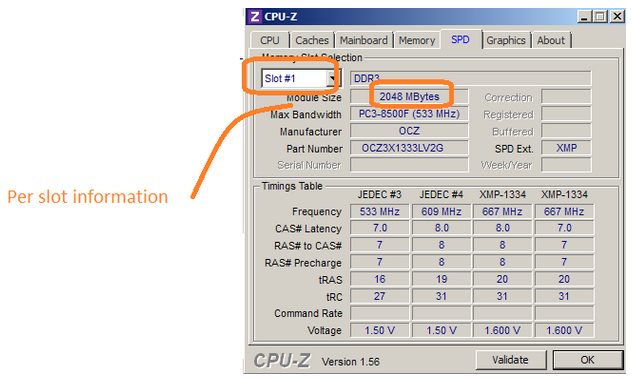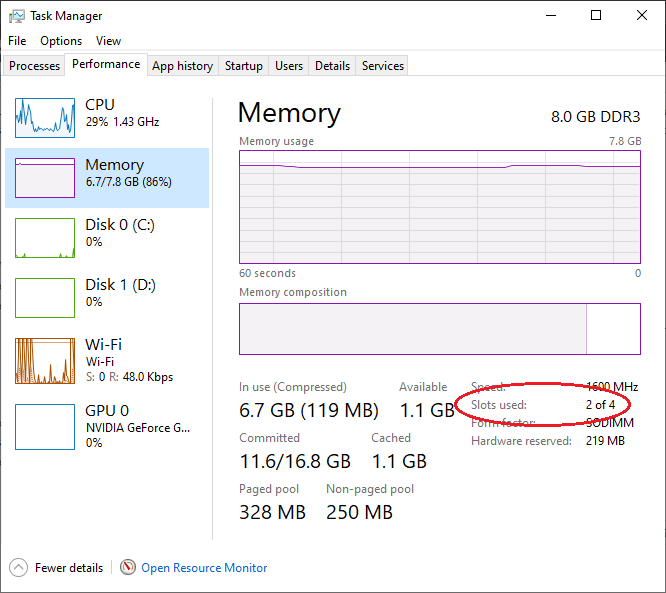Linux Get Memory Slot Information
- Linux Get Memory Slot Information Check
- Linux Free Memory
- Linux Get Memory Speed
- Linux Check Memory Info
It is essential that your Linux system runs at an optimal level. A few simple terminal commands provide access to all relevant information and help you monitor memory statistics.
In this tutorial, learn five powerful commands to check memory usage in Linux.
Linux Get Memory Slot Information Check
We also provide detailed explanations of what they do and more importantly, how to interpret the results. The commands will work with nearly all Linux distributions. In this instance, the commands and the results are presented using Ubuntu 18.04
- Access to a command line / terminal
- User with sudo privileges
- The apt package manager
Entering cat /proc/meminfo in your terminal opens the /proc/meminfo file.
10 Linux Free Command Examples. This article provides some useful examples of “free” commands with options, that might be useful for you to better utilize memory that you have. Display System Memory. Free command used to check the used and available space of physical memory and swap memory in KB. See the command in action below. Memconf is a simple perl script that displays memory modules installed in a Linux, Unix, Sun/Oracle Solaris, and HP-UX system. Make sure you have installed perl before using this script. To install perl on Arch Linux and its derivatives, run: $ sudo pacman -S perl.

Top command is mainly used to display dynamic real-time view of a running system especially the Linux processes or threads currently being managed by the Linux kernel. But it also displays system summary information, including RAM memory and swap free and used size. To exit from top program, press Ctrl + c, or just q. This is our sixth post on getting hardware information. In this post we will see how to get RAM details such as size, speed, make, maximum capacity allowed RAM etc. We already covered some hardware related stuff in this series so far as given below. Get BIOS, Firmware, Hardware And Drivers Details in Linux/Unix What. I would like to get the available memory reported as a percentage using a Linux command line. I used the free command, but that is only giving me numbers, and there is no option for percentage.
This is a virtual file that reports the amount of available and used memory. It contains real-time information about the system’s memory usage as well as the buffers and shared memory used by the kernel. The output might differ slightly based on the architecture and operating system in question.
This is an example of what the /proc/meminfo file looks like in Ubuntu 18.04:
The terminal displays the information in kilobytes.
free Command to Display the Amount of Physical and Swap Memory
Typing freein your command terminal provides the following result:
The data represents the used/available memory and the swap memory figures in kilobytes.
| total | Total installed memory |
| used | Memory currently in use by running processes (used= total – free – buff/cache) |
| free | Unused memory (free= total – used – buff/cache) |
| shared | Memory shared by multiple processes |
| buffers | Memory reserved by the OS to allocate as buffers when process need them |
| cached | Recently used files stored in RAM |
| buff/cache | Buffers + Cache |
| available | Estimation of how much memory is available for starting new applications, without swapping. |
Compared to the /proc/meminfo file, the free command provides less information. However, it is easier to understand. The key figure being the available value as it displays how much memory is still available for running new applications.

The free command has multiple options to format the output so that it better matches your requirements. The table below lists the most useful variations of the free command.
| Options | Result |
| -b | output in bytes |
| – k | output in kilobytes |
| – m | output in megabytes |
| – g | output in gigabytes |
| – l | detailed low and high memory statistics |
| – o | old format (no -/+buffers/cache line) |
| – t | total for RAM + swap |
| – s | update every [delay] seconds |
| – c | update [count] times |
Note: As with most commands, entering man free displays an overview of all variations and descriptions of the results.
vmstat Command to Report Virtual Memory Statistics
The vmstatcommand is a useful tool that reports virtual memory statistics.
vmstat provides general information about processes, memory, paging, block IO, traps, and CPU activity.
The detailed description listed below provides an explanation for each value in case you need assistance in analyzing the results.
- Procs
- r: number of processes waiting for run time.
- b: number of processes in uninterruptible sleep.
- Memory
- swpd: amount of virtual memory used.
- free: amount of idle memory.
- buff: the amount of memory used as buffers.
- cache: amount of memory used as cache.
- Swap
- si: memory swapped in from disk (/s).
- so: memory swapped to disk (/s).
- IO
- bi: Blocks received from a block device (blocks/s).
- bo: Blocks sent to a block device (blocks/s).
- System
- in: number of interrupts per second, including the clock.
- cs: number of context switches per second.
- CPU – These are percentages of total CPU time.
- us: Time spent running non-kernel code. (user time, including nice time)
- sy: Time spent running kernel code. (system time)
- id: Time spent idle. Before Linux 2.5.41, this includes IO-wait time.
- wa: Time spent waiting for IO. Before Linux 2.5.41, included in idle.
- st: Time stolen from a virtual machine. Before Linux 2.6.11, unknown.

Linux Free Memory
The top command is useful to check memory and CPU usage per process. It displays information about:
- uptime
- average load
- tasks running
- number of users logged in
- number of CPUs/CPU utilization
- memory/swap system processes
The data is continuously updated, which allows you to follow the processes in real-time.
Aside from providing you with essential memory information, the top command provides a limited interactive interface. It is possible to manipulate and configure operations by using command-line options.
The man top command provides a comprehensive list of all available variations.
The information the htop command provides is similar to the top command. However, the real advantage to the htop command is its user-friendly environment and improved controls.
The command uses color for its output, provides full command lines for processes, as well as the option to scroll both vertically and horizontally.
Linux Get Memory Speed
The following output appears:
- The top segment provides summary information and contains graphic meters and text counters.
- The lower section structures the detailed data, per process. This allows you to perform actions on individual processes with ease.
- The shortcuts listed at the bottom of the screen will enable you to manipulate and customize the processes quickly and without the need to type specific commands.
Note: If you run into “Command ‘htop’ not found” message when trying to run the htop command, you will need to install the htop function first:
As an alternative, use the command below:
Using a graphical interface for server administration is not common practice. However, certain data sets are much clearer, with a visual representation of memory usage.
To access the System Monitor:
- Navigate to Show Applications.
- Enter System Monitor in the search bar and access the application.
- Select the Resources tab.
- A graphical overview of your memory consumption in real time, including historical information is displayed.
This guide provided several options to check memory usage on your Linux system. We learned that a single command provides an abundance of valuable data for future analysis. Learning to interpret the information correctly is critical.
Linux Check Memory Info
Now you can administer your server more efficiently.
Next you should also read

This tutorial shows how to display disk usage from a command line in Linux. It is important to know how much…
The Linux kernel is much like the central brain of the operating system. Although it is open-source – meaning…
There are many different tools for monitoring network traffic on a Linux server. Each option has its…
Reducing server response time to the bare minimum is one of the primary goals of website owners and SEO…
You have probably noticed your Linux OS slowing down, especially when working harder. Understanding CPU…